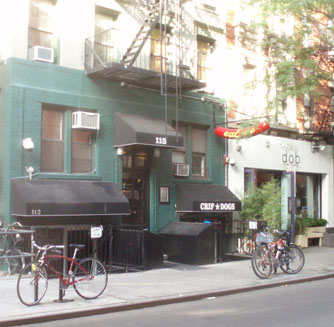

The faux speakeasy cocktail bar is the most prominent development in the Manhattan drinking scene over the last five years.
 Historically, of course, speakeasies were establishments that sold alcohol illegally. The modern speakeasy is legit, but usually concealed—as if it had something to hide. There is often a hidden or unlabeled door, and many of these places won’t admit you unless there is an open seat. There is generally a host at the door, as opposed to the usual bar, where you just saunter in and fend for yourself.
Historically, of course, speakeasies were establishments that sold alcohol illegally. The modern speakeasy is legit, but usually concealed—as if it had something to hide. There is often a hidden or unlabeled door, and many of these places won’t admit you unless there is an open seat. There is generally a host at the door, as opposed to the usual bar, where you just saunter in and fend for yourself.
Last week, I went on an East Village “pub crawl” of three speakeasy-style cocktail bars that I had long wanted to try: Please Don’t Tell, Angel’s Share, and Death & Co. (The latter two are covered in subsequent posts.) That’s probably not the best way to experience them, assuming a normal alcohol tolerance, but I wasn’t sure when I’d find another opportunity.
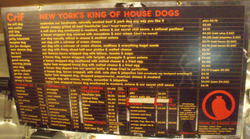 It’s hard to imagine two more incongruous establishments operating under one roof, and having common ownership, than Crif Dogs and Please Don’t Tell. From the outside, all you see is the sign for “Crif Dogs,” with a giant hot dog bearing its insoucient catch phrase, “eat me.”
It’s hard to imagine two more incongruous establishments operating under one roof, and having common ownership, than Crif Dogs and Please Don’t Tell. From the outside, all you see is the sign for “Crif Dogs,” with a giant hot dog bearing its insoucient catch phrase, “eat me.”
Inside, Crif Dogs is as divey-looking as you can imagine. Dimly lit, with a low ceiling and plain aluminum tables, it is an indoor hotdog stand. The name, by the way, is an inside joke. One of the owners (Brian Shebairo) once tried to say the name of his business partner, Chris Anista, while he had a hot dog in his mouth. It came out “Crif”.
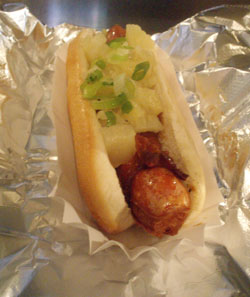 Despite the Spartan surroundings, the owners aspire to serve the city’s best hot dog, and they just might have managed it. They deep-fry the wieners in fat, locking in flavor and giving the skin a satifying crunch.
Despite the Spartan surroundings, the owners aspire to serve the city’s best hot dog, and they just might have managed it. They deep-fry the wieners in fat, locking in flavor and giving the skin a satifying crunch.
The menu (click on the image, above left, for a larger version) offers seventeen varieties of hot dogs ($2.50–5.00), along with numerous optional toppings and side dishes. Beers ($3 or less) are the only alcoholic beverages.
You can make up your own hot dog with à la carte toppings, but I decided to order the server’s recommendation, the Tsunami, a bacon-wrapped hot dog with teriyaki, pineapple, and green onions.
Such odd combinations are typical of the menu, but if the rest of their zany creations are as good as this, then consider me hooked. I didn’t taste much teriyaki, but I loved the pineapple-bacon contrast, as well as the hot dog’s crunchy casing.
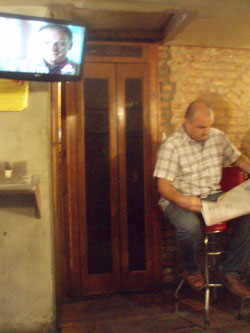 Please Don’t Tell (PDT), the adjoining cocktail lounge, does not open until 6:00 p.m. I had arrived at 5:45, which was about all the time it took to order and consume my hot dog.
Please Don’t Tell (PDT), the adjoining cocktail lounge, does not open until 6:00 p.m. I had arrived at 5:45, which was about all the time it took to order and consume my hot dog.
In the meantime, the people-watching made a fascinating study. If you didn’t know about PDT, you’d wonder about the people walking in, looking just a bit lost, dressed as if they were going to a three-star restaurant. (The PDT website doesn’t even supply an address.)
The entrance is behind a “false” unlabeled antique phone booth in a corner of Crif Dogs. Open the door, and you feel a bit foolish. There is a white phone inside. It was out of order when I visited, but when it’s working you pick up, and a hostess answers. If there is space for you, a steel door opens in the back of the booth, and you’re admitted.
Reservations at the tables notoriously sell out by mid-afternoon (they are taken same-day only), but the bar is first-come, first-served. As I was there early, I was seated immediately. Later on (or so I hear), you cool your heels with a hot dog while you wait for someone to leave, as standees aren’t admitted.
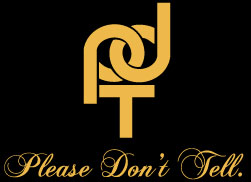 A more pronounced contrast to Crif Dogs could not be imagined. The bar is a gorgeous space. The booths and bar stools are plush and comfortable. The bartenders are solicitous, smartly dressed, and work with surgical precision. Cocktails are served with ice cubes the size of a fist—keeping the booze cold, without diluting it.
A more pronounced contrast to Crif Dogs could not be imagined. The bar is a gorgeous space. The booths and bar stools are plush and comfortable. The bartenders are solicitous, smartly dressed, and work with surgical precision. Cocktails are served with ice cubes the size of a fist—keeping the booze cold, without diluting it.
The menu lists a couple of dozen specialty cocktails, though you can also go off-book. But as this was my first visit, I stuck with the printed list.
The two cocktails I had are typical. A Benton’s Old Fashioned (bacon-infused bourbon, maple syrup, angostura bitters) had a deep smokey flavor. The Mariner (scotch whiskey, pineapple, citrus, and smoked cardamom syrup) offered a nice balance of citrus sweetness and the bitterness of the scotch.
The restroom has a long list of etiquette rules posted, which perhaps shows how hard it is to run a Serious Cocktail Bar in the East Village. For instance, “No PDA at PDT: hands on table, tongue inside your mouth.” Another warns customers not to try to hit on other patrons’ dates. I don’t recall any other bar that found it necessary to point these things out.
 They serve food here too—mostly hot dogs, though different recipes than those offered on the Crif Dogs menu. One is named for David Chang (wrapped in bacon and smothered in a kimchee puree); another for WD~50 chef Wylie Dufresne. There’s also a cheeseburger, and what appeared to be the most popular offering, tater tots.
They serve food here too—mostly hot dogs, though different recipes than those offered on the Crif Dogs menu. One is named for David Chang (wrapped in bacon and smothered in a kimchee puree); another for WD~50 chef Wylie Dufresne. There’s also a cheeseburger, and what appeared to be the most popular offering, tater tots.
These offerings come from the Crif Dogs kitchen. When the food is ready, a low buzzer rings, and the bartender opens a small metal door, with a pass-through direct to the Crif Dogs side of the house.
In some ways, this minimal menu doesn’t seem equal to the surroundings , but I admit my curiosity to try any hot dog named after Wylie Dufresne. However, I’d already had one next door, so that will have to await another visit.
This is a relaxing place. Had I not been alone, I would probably have stayed longer. Since hitting on other guys’ dates is a no-no, I’ll have to bring my own next time.
Crif Dogs & Please Don’t Tell (113 St. Marks Place between First Avenue & Avenue A, East Village)
 Monday, December 6, 2010 at 02:17PM
Monday, December 6, 2010 at 02:17PM  A couple of years ago, the East Village speakeasy bar Please Don’t Tell began to offer hot dogs inspired by local chefs, such as the Chang Dog and the Wylie Dog. (PDT’s adjoining sister joint, Crif Dogs, probably makes the city’s best hot dogs—the best we’ve tasted, at any rate.)
A couple of years ago, the East Village speakeasy bar Please Don’t Tell began to offer hot dogs inspired by local chefs, such as the Chang Dog and the Wylie Dog. (PDT’s adjoining sister joint, Crif Dogs, probably makes the city’s best hot dogs—the best we’ve tasted, at any rate.) The Humm Dog (pronounced whom dog) has returned, but only for the month of December. It’s still $6.
The Humm Dog (pronounced whom dog) has returned, but only for the month of December. It’s still $6.

























































